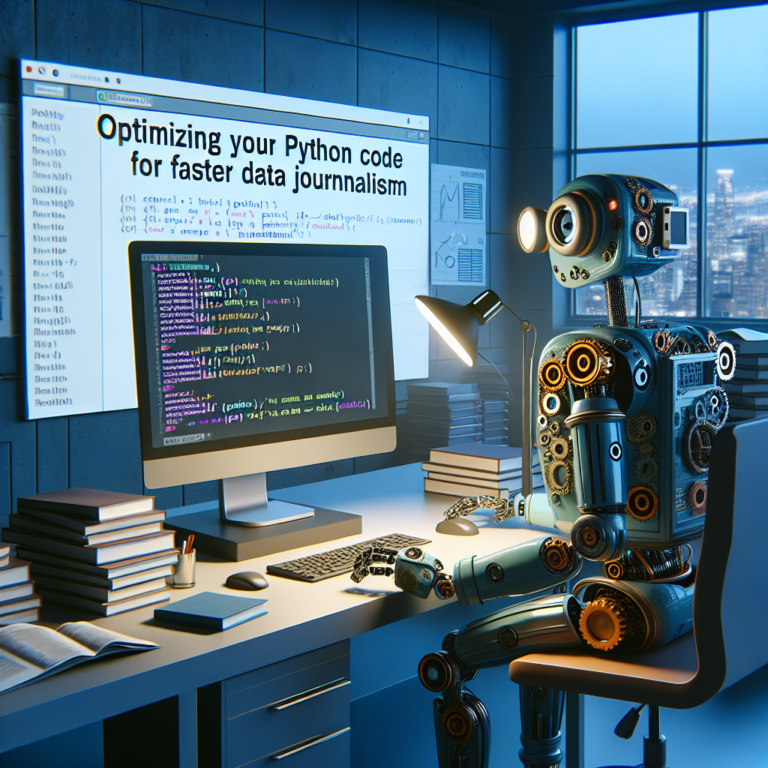1. Exploring Python NLP Tools and Libraries
When embarking on a journey through Python NLP (Natural Language Processing), the first step is to familiarize yourself with the essential tools and libraries available. Python, known for its rich ecosystem, offers several powerful libraries tailored for textual data analysis and content analysis.
NLTK (Natural Language Toolkit) is one of the most popular Python libraries for NLP. It provides easy-to-use interfaces to over 50 corpora and lexical resources such as WordNet, along with a suite of text processing libraries for classification, tokenization, stemming, tagging, parsing, and semantic reasoning.
spaCy is another robust library designed for fast NLP tasks. It excels in large-scale information extraction tasks and is built to be production-ready. spaCy focuses on providing software for deep learning workflows that can be connected to pre-trained language processing pipelines.
TextBlob is perfect for beginners and offers a simple API for common NLP tasks such as part-of-speech tagging, noun phrase extraction, sentiment analysis, classification, translation, and more. It is built on top of NLTK and provides an easy to navigate interface.
# Example of using TextBlob for simple sentiment analysis from textblob import TextBlob text = "Python makes natural language processing fun and simple." blob = TextBlob(text) print(blob.sentiment)
For those interested in machine learning, gensim is a useful library that specializes in topic modeling and document similarity analysis. It is particularly good at handling large text collections and offers an easy way to perform complex tasks like topic modeling.
Each of these tools offers unique features and capabilities, making them indispensable for anyone looking to conduct comprehensive content analysis using Python. Whether you are a beginner or an advanced user, the Python ecosystem has the right tools to meet your NLP needs.
2. Setting Up Your Python Environment for NLP
Setting up your Python environment is a crucial step for effective textual data analysis using NLP tools. This setup ensures that all necessary libraries and dependencies are correctly installed and configured.
Firstly, you need to install Python. It’s recommended to use Python 3.6 or newer. You can download it from the official Python website. Once Python is installed, setting up a virtual environment is advisable to manage dependencies efficiently.
# Creating a virtual environment python -m venv my_nlp_project
Activate your virtual environment:
# On Windows my_nlp_project\Scripts\activate # On MacOS/Linux source my_nlp_project/bin/activate
With the environment set, install the primary NLP libraries, NLTK and spaCy. Use pip, Python’s package installer.
# Installing NLTK pip install nltk # Installing spaCy pip install spacy
After installing spaCy, download a language model. This model is crucial for content analysis tasks such as tokenization and part-of-speech tagging.
# Download the English model for spaCy python -m spacy download en_core_web_sm
Finally, verify the installations by importing the libraries and loading the spaCy model to ensure everything is set up correctly.
# Testing the setup
import nltk
import spacy
nlp = spacy.load('en_core_web_sm')
print("Setup complete!")
This setup forms the backbone of your NLP projects, allowing you to proceed with confidence in your Python NLP endeavors.
3. Basic Text Processing with Python
Basic text processing is foundational in Python NLP and involves several key techniques that allow you to prepare textual data for deeper analysis. This section covers the essential steps you’ll need to handle text effectively.
Tokenization is the first step, where text is split into sentences or words. This helps in breaking down large texts into manageable pieces. Python’s NLTK library provides straightforward methods for this:
# Example of tokenization using NLTK from nltk.tokenize import word_tokenize sample_text = "Hello, welcome to Python NLP." tokens = word_tokenize(sample_text) print(tokens)
Stop Words Removal is another crucial step. Stop words (common words like ‘and’, ‘the’, etc.) are usually filtered out before processing text. NLTK includes a list of stop words that can be easily removed:
# Removing stop words with NLTK
from nltk.corpus import stopwords
stop_words = set(stopwords.words('english'))
filtered_tokens = [word for word in tokens if not word in stop_words]
print(filtered_tokens)
Stemming and Lemmatization are techniques used to reduce words to their base or root form. While stemming cuts off the ends of words, lemmatization considers the context and converts the word to its meaningful base form. Here’s how you can implement these in Python:
# Stemming and Lemmatization with NLTK
from nltk.stem import PorterStemmer, WordNetLemmatizer
stemmer = PorterStemmer()
lemmatizer = WordNetLemmatizer()
stemmed_words = [stemmer.stem(word) for word in filtered_tokens]
lemmatized_words = [lemmatizer.lemmatize(word) for word in filtered_tokens]
print("Stemmed Words:", stemmed_words)
print("Lemmatized Words:", lemmatized_words)
These basic text processing steps are vital for cleaning and preparing your data for more complex content analysis tasks in Python NLP. By mastering these techniques, you set a strong foundation for advanced NLP operations.
4. Advanced Text Analysis Techniques
Once you have mastered basic text processing, you can move on to more advanced text analysis techniques. These methods allow for deeper insights into textual data analysis and are essential for sophisticated content analysis using Python NLP.
Sentiment Analysis is a popular technique that helps determine the emotional tone behind a body of text. This is useful in social media monitoring, market research, and more. Python’s NLTK library can be used to perform sentiment analysis with ease:
# Example of sentiment analysis using NLTK from nltk.sentiment import SentimentIntensityAnalyzer sia = SentimentIntensityAnalyzer() text = "Python NLP makes text analysis exciting and productive." print(sia.polarity_scores(text))
Topic Modeling is another advanced technique that identifies topics in a large corpus of text. Libraries like Gensim make it straightforward to apply algorithms like Latent Dirichlet Allocation (LDA) for this purpose:
# Example of topic modeling using Gensim from gensim import corpora, models texts = [doc.split() for doc in documents] dictionary = corpora.Dictionary(texts) corpus = [dictionary.doc2bow(text) for text in texts] lda_model = models.LdaModel(corpus, num_topics=3, id2word=dictionary, passes=15) lda_model.print_topics(num_words=3)
Named Entity Recognition (NER) is crucial for extracting entities such as names, locations, and dates from text. SpaCy provides an efficient way to perform NER with pre-trained models:
# Named Entity Recognition with spaCy
import spacy
nlp = spacy.load('en_core_web_sm')
doc = nlp("Apple is looking at buying U.K. startup for $1 billion")
for ent in doc.ents:
print(ent.text, ent.label_)
These advanced techniques enhance your ability to analyze and interpret large volumes of text, providing valuable insights that are not apparent from a superficial reading. By leveraging these methods, you can uncover patterns and trends that inform decision-making and strategy in business, research, and beyond.
5. Visualizing Text Analysis Results
Visualizing the results of textual data analysis is crucial for interpreting complex data and sharing findings effectively. Python offers several libraries that can help you create insightful visualizations for your content analysis projects.
Matplotlib and Seaborn are two of the most popular libraries for creating static, animated, and interactive visualizations in Python. They are especially useful for plotting histograms, bar charts, and scatter plots that can illustrate the frequency and distribution of words or concepts within the dataset.
# Example of using Matplotlib to plot word frequencies
import matplotlib.pyplot as plt
word_freq = {'Python': 10, 'NLP': 15, 'Data': 7, 'Analysis': 5}
plt.bar(word_freq.keys(), word_freq.values())
plt.xlabel('Words')
plt.ylabel('Frequency')
plt.title('Word Frequency in Textual Data')
plt.show()
For more advanced visualizations, WordCloud is a tool that allows you to create attractive and informative word clouds. These clouds can be a great way to visually represent the most prominent words in a text, making it easier to identify key themes and concepts at a glance.
# Generating a word cloud with WordCloud
from wordcloud import WordCloud
text = 'Python NLP provides powerful tools for textual data analysis'
wordcloud = WordCloud(width=800, height=400).generate(text)
plt.figure(figsize=(10, 5))
plt.imshow(wordcloud)
plt.axis('off')
plt.show()
Lastly, Plotly offers interactive graphs that are web-friendly and can be a dynamic way to present content analysis results. Interactive charts allow viewers to engage with the data, exploring different aspects of the analysis through zooming and hovering to see detailed information.
By utilizing these visualization tools, you can enhance the accessibility and impact of your Python NLP projects, making your findings both compelling and easy to understand.
6. Case Studies: Real-World Applications of Python NLP
Exploring real-world applications of Python NLP showcases the practical impact of textual data analysis and content analysis across various industries. Here are a few case studies that illustrate the versatility and power of Python’s NLP capabilities.
Customer Service Automation: Many companies use Python NLP to enhance their customer service. By implementing chatbots that understand and process natural language, businesses can provide instant responses to customer inquiries, significantly improving response times and customer satisfaction.
# Example of a simple chatbot using NLTK
from nltk.chat.util import Chat, reflections
pairs = [
[r"hi|hello", ["Hello, how can I help you today?"]],
[r"(.*) your name?", ["I am a chatbot created using Python's NLTP toolkit."]]
]
chat = Chat(pairs, reflections)
chat.converse()
Healthcare Data Analysis: Python NLP tools are instrumental in extracting meaningful information from unstructured clinical data. This application helps in identifying trends and patterns that are crucial for medical research and patient care management.
Social Media Sentiment Analysis: Companies often analyze social media posts to gauge public sentiment about their products or services. Python’s NLP tools can automate this process, providing insights into consumer behavior and helping companies tailor their marketing strategies effectively.
# Analyzing sentiment from tweets using TextBlob from textblob import TextBlob tweet = "I love using Python for data analysis!" blob = TextBlob(tweet) print(blob.sentiment)
These case studies demonstrate the broad applicability of NLP in automating tasks, extracting insights, and enhancing user interactions across different sectors. By leveraging Python’s NLP tools, organizations can harness the power of language data to drive innovation and efficiency.



